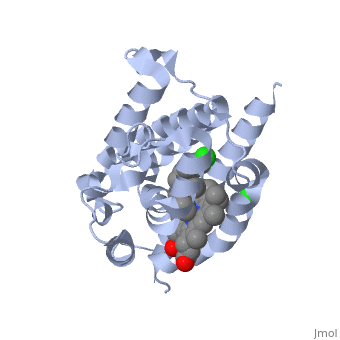2dy5: Difference between revisions
No edit summary |
No edit summary |
||
| Line 3: | Line 3: | ||
<StructureSection load='2dy5' size='340' side='right'caption='[[2dy5]], [[Resolution|resolution]] 2.70Å' scene=''> | <StructureSection load='2dy5' size='340' side='right'caption='[[2dy5]], [[Resolution|resolution]] 2.70Å' scene=''> | ||
== Structural highlights == | == Structural highlights == | ||
<table><tr><td colspan='2'>[[2dy5]] is a 1 chain structure with sequence from [https://en.wikipedia.org/wiki/ | <table><tr><td colspan='2'>[[2dy5]] is a 1 chain structure with sequence from [https://en.wikipedia.org/wiki/Rattus_norvegicus Rattus norvegicus]. Full crystallographic information is available from [http://oca.weizmann.ac.il/oca-bin/ocashort?id=2DY5 OCA]. For a <b>guided tour on the structure components</b> use [https://proteopedia.org/fgij/fg.htm?mol=2DY5 FirstGlance]. <br> | ||
</td></tr><tr id='ligand'><td class="sblockLbl"><b>[[Ligand|Ligands:]]</b></td><td class="sblockDat" id="ligandDat"><scene name='pdbligand=224:1-({2-[2-(4-CHLOROPHENYL)ETHYL]-1,3-DIOXOLAN-2-YL}METHYL)-1H-IMIDAZOLE'>224</scene>, <scene name='pdbligand=CL:CHLORIDE+ION'>CL</scene>, <scene name='pdbligand=HEM:PROTOPORPHYRIN+IX+CONTAINING+FE'>HEM</scene | </td></tr><tr id='method'><td class="sblockLbl"><b>[[Empirical_models|Method:]]</b></td><td class="sblockDat" id="methodDat">X-ray diffraction, [[Resolution|Resolution]] 2.7Å</td></tr> | ||
<tr id='ligand'><td class="sblockLbl"><b>[[Ligand|Ligands:]]</b></td><td class="sblockDat" id="ligandDat"><scene name='pdbligand=224:1-({2-[2-(4-CHLOROPHENYL)ETHYL]-1,3-DIOXOLAN-2-YL}METHYL)-1H-IMIDAZOLE'>224</scene>, <scene name='pdbligand=CL:CHLORIDE+ION'>CL</scene>, <scene name='pdbligand=HEM:PROTOPORPHYRIN+IX+CONTAINING+FE'>HEM</scene></td></tr> | |||
<tr id='resources'><td class="sblockLbl"><b>Resources:</b></td><td class="sblockDat"><span class='plainlinks'>[https://proteopedia.org/fgij/fg.htm?mol=2dy5 FirstGlance], [http://oca.weizmann.ac.il/oca-bin/ocaids?id=2dy5 OCA], [https://pdbe.org/2dy5 PDBe], [https://www.rcsb.org/pdb/explore.do?structureId=2dy5 RCSB], [https://www.ebi.ac.uk/pdbsum/2dy5 PDBsum], [https://prosat.h-its.org/prosat/prosatexe?pdbcode=2dy5 ProSAT]</span></td></tr> | <tr id='resources'><td class="sblockLbl"><b>Resources:</b></td><td class="sblockDat"><span class='plainlinks'>[https://proteopedia.org/fgij/fg.htm?mol=2dy5 FirstGlance], [http://oca.weizmann.ac.il/oca-bin/ocaids?id=2dy5 OCA], [https://pdbe.org/2dy5 PDBe], [https://www.rcsb.org/pdb/explore.do?structureId=2dy5 RCSB], [https://www.ebi.ac.uk/pdbsum/2dy5 PDBsum], [https://prosat.h-its.org/prosat/prosatexe?pdbcode=2dy5 ProSAT]</span></td></tr> | ||
</table> | </table> | ||
== Function == | == Function == | ||
[https://www.uniprot.org/uniprot/HMOX1_RAT HMOX1_RAT] Heme oxygenase cleaves the heme ring at the alpha methene bridge to form biliverdin. Biliverdin is subsequently converted to bilirubin by biliverdin reductase. Under physiological conditions, the activity of heme oxygenase is highest in the spleen, where senescent erythrocytes are sequestrated and destroyed. | |||
== Evolutionary Conservation == | == Evolutionary Conservation == | ||
[[Image:Consurf_key_small.gif|200px|right]] | [[Image:Consurf_key_small.gif|200px|right]] | ||
| Line 37: | Line 37: | ||
__TOC__ | __TOC__ | ||
</StructureSection> | </StructureSection> | ||
[[Category: Large Structures]] | [[Category: Large Structures]] | ||
[[Category: | [[Category: Rattus norvegicus]] | ||
[[Category: | [[Category: Fukuyama K]] | ||
[[Category: | [[Category: Sugishima M]] | ||
[[Category: | [[Category: Takahashi H]] | ||
Latest revision as of 11:32, 25 October 2023
Crystal structure of rat heme oxygenase-1 in complex with heme and 2-[2-(4-chlorophenyl)ethyl]-2-[(1H-imidazol-1-yl)methyl]-1,3-dioxolaneCrystal structure of rat heme oxygenase-1 in complex with heme and 2-[2-(4-chlorophenyl)ethyl]-2-[(1H-imidazol-1-yl)methyl]-1,3-dioxolane
Structural highlights
FunctionHMOX1_RAT Heme oxygenase cleaves the heme ring at the alpha methene bridge to form biliverdin. Biliverdin is subsequently converted to bilirubin by biliverdin reductase. Under physiological conditions, the activity of heme oxygenase is highest in the spleen, where senescent erythrocytes are sequestrated and destroyed. Evolutionary Conservation Check, as determined by ConSurfDB. You may read the explanation of the method and the full data available from ConSurf. Publication Abstract from PubMedHeme oxygenase (HO) catalyzes the regiospecific cleavage of the porphyrin ring of heme using reducing equivalents and O2 to produce biliverdin, iron, and CO. Because CO has a cytoprotective effect through the p38-MAPK pathway, HO is a potential therapeutic target in cancer. In fact, inhibition of the HO isoform HO-1 reduces Kaposi sarcoma tumor growth. Imidazole-dioxolane compounds have recently attracted attention because they have been reported to specifically inhibit HO-1, but not HO-2, unlike Cr-containing protoporphyrin IX, a classical inhibitor of HO, that inhibits not only both HO isoforms but also other hemoproteins. The inhibitory mechanism of imidazole-dioxolane compounds, however, has not yet been characterized. Here, we determine the crystal structure of the ternary complex of rat HO-1, heme, and an imidazole-dioxolane compound, 2-[2-(4-chlorophenyl)ethyl]-2-[(1H-imidazol-1-yl)methyl]-1,3-dioxolane. This compound bound on the distal side of the heme iron, where the imidazole and 4-chlorophenyl groups were bound to the heme iron and the hydrophobic cavity in HO, respectively. Binding of the bulky inhibitor in the narrow distal pocket shifted the distal helix to open the distal site and moved both the heme and the proximal helix. Furthermore, the biochemical characterization revealed that the catalytic reactions of both HO-1 and HO-2 were completely stopped after the formation of verdoheme in the presence of the imidazole-dioxolane compound. This result should be mainly due to the lower reactivity of the inhibitor-bound verdoheme with O2 compared to the reactivity of the inhibitor-bound heme with O2. X-ray crystallographic and biochemical characterization of the inhibitory action of an imidazole-dioxolane compound on heme oxygenase.,Sugishima M, Higashimoto Y, Oishi T, Takahashi H, Sakamoto H, Noguchi M, Fukuyama K Biochemistry. 2007 Feb 20;46(7):1860-7. Epub 2007 Jan 25. PMID:17253780[1] From MEDLINE®/PubMed®, a database of the U.S. National Library of Medicine. See AlsoReferences
|
| ||||||||||||||||||
